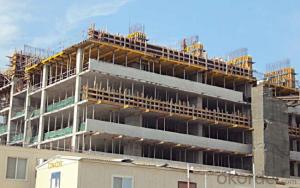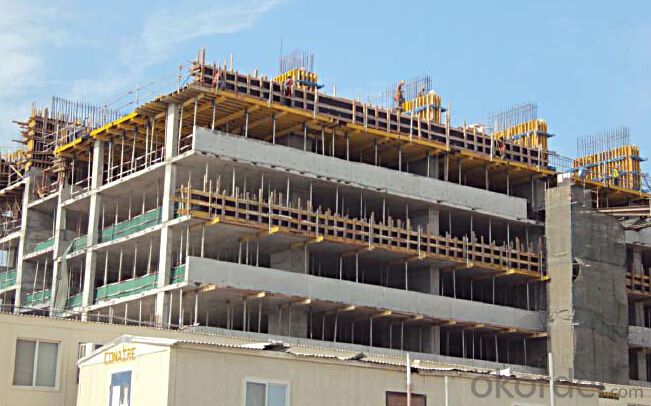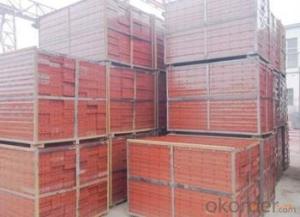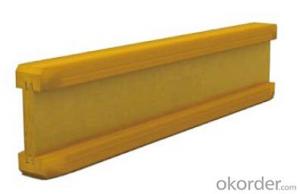Timber-beam Formwork H20 for formwork and scaffolding system
- Loading Port:
- Tianjin
- Payment Terms:
- TT OR LC
- Min Order Qty:
- 50 m²
- Supply Capability:
- 1000 m²/month
OKorder Service Pledge
OKorder Financial Service
You Might Also Like
Characteristics:
◆ Standardized production lines.
Supply capability: 3000m/day, Lmax = 6600mm.
◆ Finger jointing of the flange and web, the strength of timber beam is highly improved.
Max. shearing force failure load:40KN
◆ Well treated to prevent from water penetration or erosion, so the service life maximally
extended.
Normally, CNBM timber beam H20 can be used for 4 to 5 years, the exact using time would
depend on maintenance & storage.
◆ Robust caps at the end of the girders protect against damages.
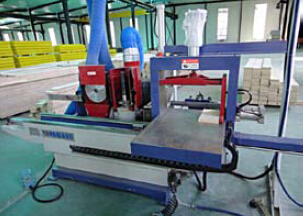


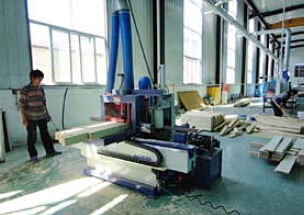
- Q: Can steel formwork be used in educational or institutional construction projects?
- Yes, steel formwork can be used in educational or institutional construction projects. Steel formwork is a versatile and durable solution that can provide many benefits in such projects. Firstly, steel formwork offers high strength and stability, which is essential in constructing large and complex structures typically found in educational or institutional buildings. It can withstand heavy loads and provides a secure framework for concrete placement. This is particularly important in projects where there are multiple levels or large spans. Secondly, steel formwork is reusable, which can significantly reduce construction costs and waste. Once the concrete has set, the steel formwork can be removed and used again in another section of the building or in future projects. This not only saves money but also contributes to sustainability efforts by minimizing the need for new materials. Thirdly, steel formwork allows for precise and accurate construction. It can be easily adjusted and modified to accommodate various architectural and design requirements. This is especially crucial in educational or institutional buildings where specific layouts and dimensions are needed to meet the functional needs of classrooms, laboratories, offices, or other facilities. Moreover, steel formwork enables faster construction compared to traditional timber formwork. Its lightweight nature and ease of assembly make it more efficient, reducing construction time and enabling earlier project completion. This is particularly beneficial in educational or institutional projects where there might be tight deadlines due to academic schedules or other time constraints. Finally, steel formwork offers enhanced safety measures during construction. Its robust structure ensures stability, reducing the risk of accidents or structural failures. Additionally, steel formwork can provide a safer working environment for construction workers, as it eliminates the need for excessive scaffolding or temporary supports. In conclusion, steel formwork is a suitable choice for educational or institutional construction projects. It provides strength, durability, reusability, precision, efficiency, and safety, making it a highly beneficial solution for constructing complex and functional buildings.
- Q: Can steel formwork be used for both straight and curved walls?
- Steel formwork is versatile and can be utilized for both straight and curved walls. With its exceptional strength and durability, it is ideal for shaping walls of diverse sizes and shapes. Its flexibility allows for effortless adjustments and customization, enabling the creation of both straight and curved walls. The precision and accuracy offered by the steel formwork system ensures that the walls are constructed to the desired specifications. Moreover, the reusability of steel formwork makes it a cost-effective option for projects involving both straight and curved walls.
- Q: How does steel formwork contribute to the overall durability of the concrete structure?
- Steel formwork contributes to the overall durability of a concrete structure in several ways. Firstly, steel formwork provides a strong and rigid framework for pouring and shaping the concrete. This ensures that the concrete is properly supported during the curing process, preventing any deformation or collapse that could compromise the structure's integrity. Additionally, steel formwork is highly resistant to the corrosive effects of concrete, which contains alkaline substances that can slowly erode other materials over time. This resistance to corrosion ensures that the formwork remains stable and intact throughout the construction process, maintaining the shape and dimensions of the concrete elements. Moreover, steel formwork allows for precise and accurate construction, resulting in a concrete structure with consistent dimensions and smooth finishes. This precision minimizes the chances of structural weaknesses or flaws in the concrete, enhancing its overall durability. Furthermore, steel formwork is reusable, making it a cost-effective option for construction projects. By using steel formwork multiple times, the overall durability of the concrete structure is improved as the formwork retains its strength and stability over numerous applications. In conclusion, steel formwork plays a crucial role in enhancing the overall durability of a concrete structure. Its strength, resistance to corrosion, precision, and reusability ensure that the concrete is properly supported, accurately constructed, and able to withstand external forces, contributing to a long-lasting and robust structure.
- Q: How does steel formwork contribute to the efficiency of construction processes?
- Steel formwork contributes to the efficiency of construction processes by providing a durable and reusable framework for casting concrete structures. Its strength and rigidity allow for faster construction progress, as it can withstand the pressure exerted by wet concrete, resulting in shorter construction cycles. Additionally, steel formwork allows for precise and accurate shaping of concrete elements, ensuring the desired dimensions and quality of the final product. Its reusability minimizes waste, reduces costs, and promotes sustainability in construction projects.
- Q: Can steel formwork be used for commercial construction projects?
- Yes, steel formwork can be used for commercial construction projects. Steel formwork offers durability, strength, and the ability to withstand heavy loads, making it a suitable choice for large-scale construction projects such as commercial buildings. It provides a stable and reusable solution that allows for efficient and precise concrete placement, ensuring high-quality results.
- Q: How is steel formwork manufactured?
- Steel formwork is manufactured by cutting and shaping steel plates and bars according to the required dimensions and designs. These steel components are then welded together to form the desired formwork panels, beams, and columns. The steel formwork is further reinforced with additional steel bars and mesh, and the surfaces are treated to resist corrosion. Finally, the formwork is assembled and prepared for use in construction projects.
- Q: What is the difference between the steel template and the wood template? When to use steel formwork? When to use a wooden template?Now what kind of use
- Template in the development, of course, the difference is different material, steel template stiffness, small deformation
- Q: What are the different types of connections used in steel formwork?
- There are several types of connections used in steel formwork, including bolted connections, welded connections, and clamped connections. Bolted connections involve using bolts and nuts to secure the formwork together, ensuring a strong and secure connection. Welded connections involve welding the steel plates or components together, creating a permanent and durable connection. Clamped connections use clamps to hold the formwork in place, providing a quick and adjustable connection method. Each type of connection has its advantages and is chosen based on the specific requirements of the project.
- Q: What are the different types of release agents used with steel formwork?
- There are several types of release agents used with steel formwork, including petroleum-based agents, water-based agents, silicone-based agents, and wax-based agents. These release agents are applied to the surface of the formwork to prevent the concrete from sticking to it during the pouring and curing process. Each type of release agent has its own advantages and suitability for different applications, depending on factors such as the desired finish, ease of application, and environmental considerations.
- Q: How does steel formwork affect the overall durability of the structure?
- Steel formwork can significantly enhance the overall durability of a structure. Its robustness and strength provide excellent support and stability during the concrete pouring process, ensuring that the structure maintains its intended shape and alignment. Steel formwork also offers exceptional resistance to deformation, making it highly durable and capable of withstanding the pressures exerted by the concrete. Moreover, steel formwork reduces the risk of cracks and structural failures, resulting in a more long-lasting and resilient structure.
Send your message to us
Timber-beam Formwork H20 for formwork and scaffolding system
- Loading Port:
- Tianjin
- Payment Terms:
- TT OR LC
- Min Order Qty:
- 50 m²
- Supply Capability:
- 1000 m²/month
OKorder Service Pledge
OKorder Financial Service
Similar products
Hot products
Hot Searches
Related keywords

